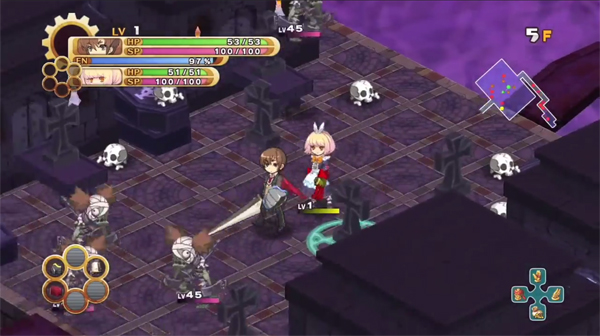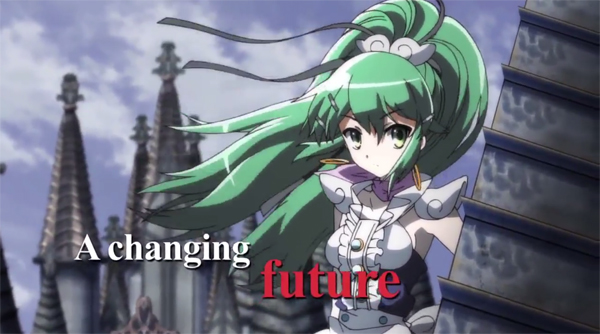
Right before the tutorial begins, The Guided Fate Paradox asks: “Have you had any experience being God before?” (translation: skip the tutorial)
Your choices are:
> O-of course not!
> I’ve got a black belt in God-kwan-do
The premise of The Guided Fate Paradox is that a Japanese high school student wins the lottery. His prize is to become God. This is never not funny. Regular exchanges in this game: “Sup’? I’m God.” “Will I ever see you again?” “Probably not. I’m God.” This lightens the often obscure, usually amusing, frequently awkward, jarringly serious, and very, very anime story of The Guided Fate Paradox.
As expected from the makers of Disgaea, the story is wacky and strange, yet it still asks to be taken seriously at times. There is absolutely no chance of that happening. Here I am, rolling my eyes, saying “oh gosh this is so silly and hahaha did that seriously just happen” because every main character is an angel wearing a french maid or butler costume. They all have ridiculous, exaggerated personality types like “over-sexualized nurse,” “uptight pretty boy,” and “Vampire the Masquerade LARP.”
But after about ten hours of these idiot goofballs, I realize: “help, I actually am starting to care a huge, embarrassing amount for them and their incomprehensible melodrama!” Nippon Ichi’s formula for success has been to not take itself seriously except when it suddenly does. Even though this technique is as awkward in The Guided Fate Paradox as it ever has been, it turns out to work on me really well! I feel like I should be kind of not so forthcoming about that. Whoops.
The plot is great, because it doesn’t make any sense at all, and nobody in the story cares. Here is one weird tip for game designers who do not like terrible stories: if you don’t take yourselves too seriously, you don’t have to waste your time explaining all of the videogame junk that is in your game because it is a videogame.
Here is the story of GFP: a pathologically generic high school boy is selected via lottery by a group of very cute and fairly sketchy angels to become God, which he does by using a machine called the Fate Revolution Circuit, which grants the wish of creatures (humans/mermaids/zombies/fictional characters) that have prayed to God by creating a copy of the wisher’s world that they can use to subtly influence the original world by killing monsters in randomly generated dungeons. Wow, right? But the game just goes on without caring.
Each dungeon revolves around one of these wishes, and the wishes are usually amusing but a bit cut-scene heavy—there’s one between each floor of the dungeon and, as this game is a roguelike, each floor takes barely as long to complete as the cut-scenes. At ten floors per dungeon, this is exactly five more cut-scenes than are needed to tell the story. The wish stories start getting repetitive very fast, even when they have interesting premises like “self aware Cinderella makes feminist reading of her own narrative” or “cowardly zombie wants to stop being bullied so he can eat human flesh” or “heartbroken mermaid wants to literally kill all men.” All these wishes are great, but they all get granted in a status quo-affirming way, which was quite a letdown.
The script is also fairly awkward, with a lot of word choices and grammatical phrasing that is technically correct but awkward to English ears—the result of literally translated Japanese that hasn’t been cleaned up. NIS America’s localization is peppered with relevant and amusing jokes (and thankfully it keeps tired memes to a minimum), though it still feels clunky at times compared to other localizers.
Okay, and this is also a video game. Because killing monsters in randomly generated dungeons helps to grant the wishes of mortal beings for Basically No Reason, The Guided Fate Paradox is a roguelike, though it is very different from the last few roguelikes I have reviewed here at Paste. There are a couple of reasons for that. One is that Japanese roguelikes have followed a very different evolutionary path than the contemporary western resurgence. Both are influenced by the almost-as-old-as-the-desktop-computer Rogue, but Japan was introduced to the genre mostly through the Super Nintendo game Mysterious Dungeon. The Guided Fate Paradox retains a lot of that game’s features, like banking items and money, and a town that persistently upgrades as you progress.
I’ve spent a lot of time talking about the story, as it’s a big part of the game, but it’s also part of the reason why The Guided Fate Paradox doesn’t actually have a lot of what I like about roguelikes. With a sweeping linear story, weird as it is, it’s not a game that you can play every once in a while for an hour or so like 868-HACK or Eldritch. It’s not a single-session game, though—there’s a host of bells and whistles that let you customize your character and become permanently more powerful as the game goes on.
Even though the systems in GFP are both overly complicated and completely broken (that is to say, well-designed), what I like best about other roguelikes is that they don’t bother me with stuff like this. GFP is a lot more like a JRPG tactics game that is played with a single character (and an AI partner)—so, a roguelike that isn’t much at all like Rogue. And that part is great—every equipable item also grants a useful ability, and the resource you use to activate them replenishes very quickly. Rather than tensely hoarding your most powerful skills, you get to use them all the time, plus they look delightfully absurd. Your character eventually will have a fish head and tank legs and bat wings and axes in each hand. Reminder: this person is God. Still funny.
My tolerance for trashy anime that doesn’t take itself seriously but then suddenly takes itself way too seriously is high enough that I actually kind of love this game, so take my endorsement as a warning if that does not apply to you. GFP is also still a fun and clever roguelike with tons of ridiculous abilities (such as, teleporting a random enemy or item into your hands), interesting level gimmicks (foggy oceans with hidden islands), and inventive boss levels (a giant zombie that smashes parts of the level).
One last element I like about roguelikes is that they remove anything that makes me feel that I have to invest a lot of time in a game, which lets me enjoy playing without a sense of obligation. But for a lot of people, that’s exactly what gets them immersed in a game, and The Guided Fate Paradox is a fun place to spend some time in, depending on how capable you are at going from rolling your eyes to being completely invested in the stupid melodrama of dorky anime characters. I am extremely capable.
The Guided Fate Paradox was developed by Nippon Ichi Software and published by NIS America. It is available for the PlayStation 3.
Aevee Bee is freelance writer who maintains a surreal video game terror blog at http://mammonmachine.com/ and a twitter account, @mammonmachine, which is both a popular resource for anime puns and flirtation advice.

